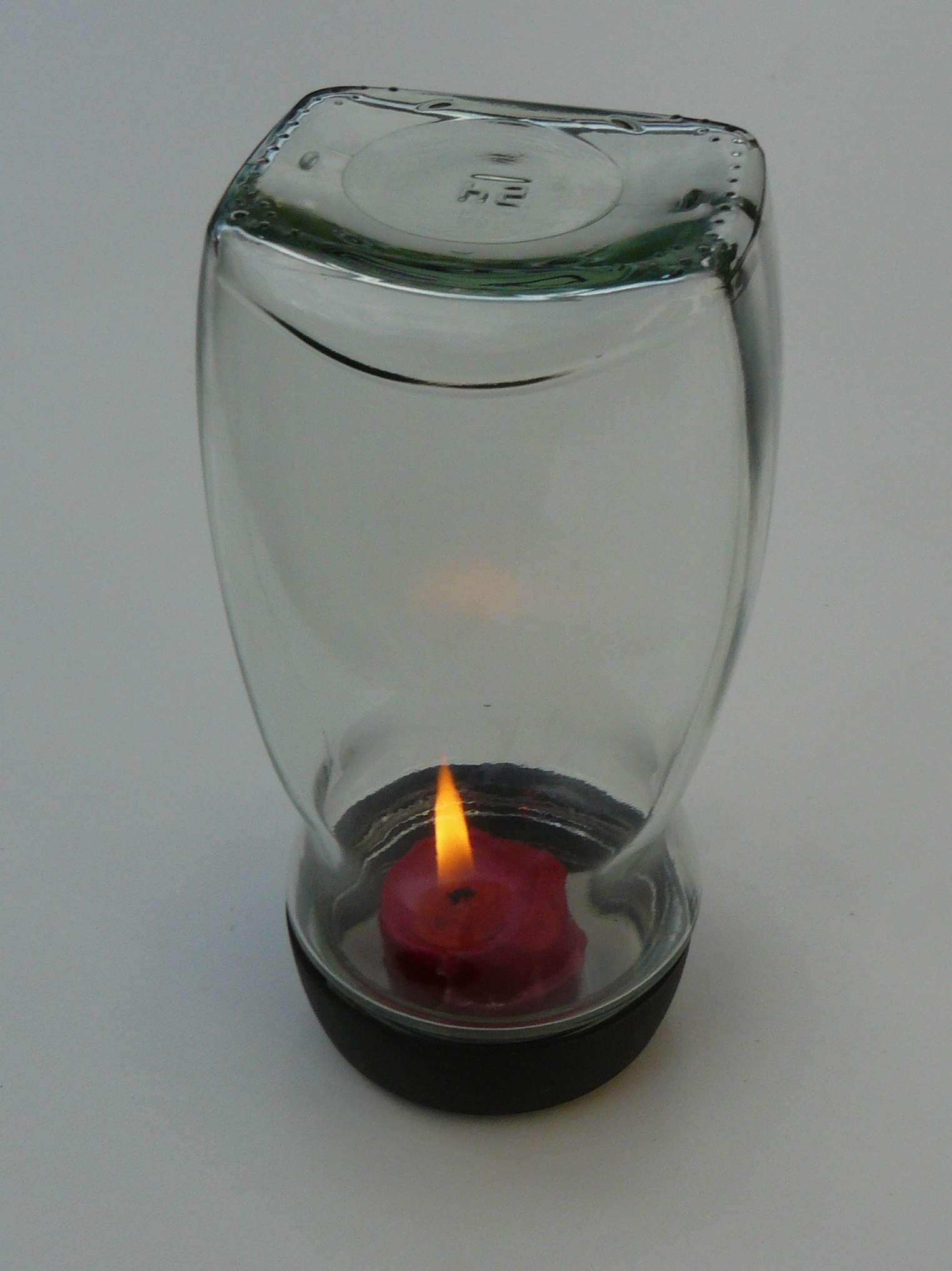20.4. Falling candle#
| Author: | Peter Dekkers |
| Time: | 5 - 10 minutes |
| Age group: | 15 - 18 |
| Concepts: | heat transfer by convection, buoyancy, weightlessness, combustion |
Introduction#
This experiment combines combustion with force and movement in a surprising way. The experiment lasts less than a second; the interesting part is predicting what will happen and finding an explanation.
This demonstration is based on experiment 62 in .
Equipment#
Tealight candle
Large transparent jar with lid
Drop of glue
Matches
Preparation#
Glue the tealight candle onto the lid of the jar. Screw the jar upside down on top of it. Practice dropping and catching the upside-down jar a few times. To be able to think along in this demonstration students should already understand how buoyancy, sinking, and heat transfer through convection come about. The explanation of the experiment relies on these principles in a not-so-obvious way.

Fig. 20.13 Tealight candle in a closed jar.#
Procedure#
Predict#
Light the tealight candle and place the jar upside down over it (the jar is standing on its lid). Students can predict that the flame will extinguish soon, and they are correct. But what will happen if you pick up the jar with the burning candle inside and then drop it?
As it falls will the flame burn brighter, remain equally bright, or become less bright? And why do they expect that? Take some time to gather predictions and corresponding explanations. Then try it out.
Observe#
First observe that indeed the flame goes out after quite some time in a closed jar. Then relight the tealight candle and let a strong flame develop. Place the jar back on the lid, hold it high in front of you, and drop it. A drop of about half a meter is sufficient, then catch it again.
The flame has been extinguished much faster than before, so this is not because there is insufficient oxygen. Why then?
Tip
To drop the jar vertically, hold it on both sides and move your hands along with the fall. Guide the observation because it happens quickly: ‘Pay close attention, does the candle go out when I’m catching it or sooner?’ If necessary, let the jar drop further, onto a cushion or into sand.
Answering the question of why the tealight candle goes out can be supported by asking further questions, for example, as follows:
A flame needs oxygen to burn. What process provides the oxygen?
Hot air ‘rises’. What process causes that?
Does a cork float in water when both the cork and the water are in free fall? Does a stone sink in falling water? How do the upward and downward force on an object in a fluid medium compare, during free fall?
Explain#
Discuss which of the predictions have come true. Evaluate the given explanations. Explain, if necessary, what physicists think about it.
Physics background#
For the flame to burn, a continuous supply of oxygen is required. If this supply is cut off, the combustion stops immediately. When the tealight candle is on the table, the air near the flame heats up, expands, and its density decreases, causing it to rise. The pressure around the flame decreases, and nearby oxygen-rich air is pushed towards the flame by the surrounding atmosphere.
The net upward force on the hot air is the difference between the downward gravitational pull on it and the upward force caused by surrounding cold air. This upward force is equal to the gravitational pull on an equal volume of surrounding cold air. In short, hot air floats on cold air due to the difference in gravitational pull (per unit volume) between hot and cold air.
In free fall, the gravitational downward pull on both is zero (within the falling system), and thus the difference in gravitational pull is also zero. Convection of hot air stops, and so does the supply of oxygen.
Follow-up#
For further exploration: Will the tealight candle also be extinguished if you don’t drop the jar but throw it (straight) up and catch it before it comes down? Does a flame tilt when going around a corner, and if so, in which direction (towards the inside or the outside of the curve)? How does a flame react to deceleration and acceleration?
And what happens to the parabolic trajectory of a water jet from a bottle when the bottle is dropped?
Tip
There are some marvelous movie clips on candles burning in space.
